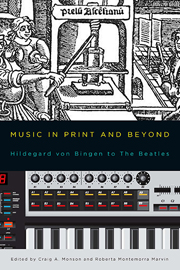Book contents
- Frontmatter
- Dedication
- Contents
- Acknowledgments
- Introduction
- 1 Robert Granjon and Music during the Golden Age of Typography
- 2 Publishing Music Theory in Early Cinquecento Venice and Bologna: Friends and Foes
- 3 Preaching to the Choir: Arts of Persuasion in the Converts of Italy
- 4 Music Distribution in London during Handel's Lifetime: Manuscript Copies versus Prints
- 5 Beethoven's Miniatures
- 6 “The Beautiful and the Ugly”: Travel Literature, Racial Theory, and a Schumann Song
- 7 Verdi's “Music of the Future”
- 8 The Suspended Voice of Amália Rodrigues
- 9 More than Mostly Mozart: Teddy Wilson's “China Boy”
- 10 Wanted Dead and Alive: Historical Performance Practice and Electro-Acoustic Music from IRCAM to Abbey Road
- 11 Lowinsky's Secrets
- 12 The Unknown Hildegard: Editing, Performance, and Reception (An Ordo Virtutum in Five Acts)
- List of Contributors
- Index
10 - Wanted Dead and Alive: Historical Performance Practice and Electro-Acoustic Music from IRCAM to Abbey Road
Published online by Cambridge University Press: 05 March 2014
- Frontmatter
- Dedication
- Contents
- Acknowledgments
- Introduction
- 1 Robert Granjon and Music during the Golden Age of Typography
- 2 Publishing Music Theory in Early Cinquecento Venice and Bologna: Friends and Foes
- 3 Preaching to the Choir: Arts of Persuasion in the Converts of Italy
- 4 Music Distribution in London during Handel's Lifetime: Manuscript Copies versus Prints
- 5 Beethoven's Miniatures
- 6 “The Beautiful and the Ugly”: Travel Literature, Racial Theory, and a Schumann Song
- 7 Verdi's “Music of the Future”
- 8 The Suspended Voice of Amália Rodrigues
- 9 More than Mostly Mozart: Teddy Wilson's “China Boy”
- 10 Wanted Dead and Alive: Historical Performance Practice and Electro-Acoustic Music from IRCAM to Abbey Road
- 11 Lowinsky's Secrets
- 12 The Unknown Hildegard: Editing, Performance, and Reception (An Ordo Virtutum in Five Acts)
- List of Contributors
- Index
Summary
A note in the score for Kaija Saariaho's NoaNoa (1992), a piece for flute, prerecorded sounds, and real-time processing, points to the remarkable degree to which electro-acoustic music is embedded in the specific moment and technologies of its creation. Saariaho composed NoaNoa at IRCAM (Institute for Research and Coordination in Acoustics and Music at the Pompidou Center, Paris) using its extensive computer music resources for analyzing and modeling instrumental timbre, reverberation, and spatial effects. After a description of all the gear required for a performance (processors, controllers, a Midi interface, Max/MSP patches, and a “Macintosh PowerPC with CD-Rom drive [compatible with system 7.1 or higher]”), she writes: “The technical information given above is correct as of September 1998, but the performer should contact the publisher for updates.”
We were once accustomed to think of the “Historical Performance Practice” movement in terms of, for example, violinists' extreme efforts to play eighteenth-century pieces with what they regarded as an appropriate technique, period bow, strings, and even an instrument with the right varnish and glue. But in contrast to the decades or even centuries we use to measure changes associated with the musical technology of the violin, with NoaNoa we see a composer compelled to indicate a specific month; the implication is that whatever hardware and software she had originally employed could be obsolete by October.
- Type
- Chapter
- Information
- Music in Print and BeyondHildegard von Bingen to The Beatles, pp. 213 - 231Publisher: Boydell & BrewerPrint publication year: 2013

